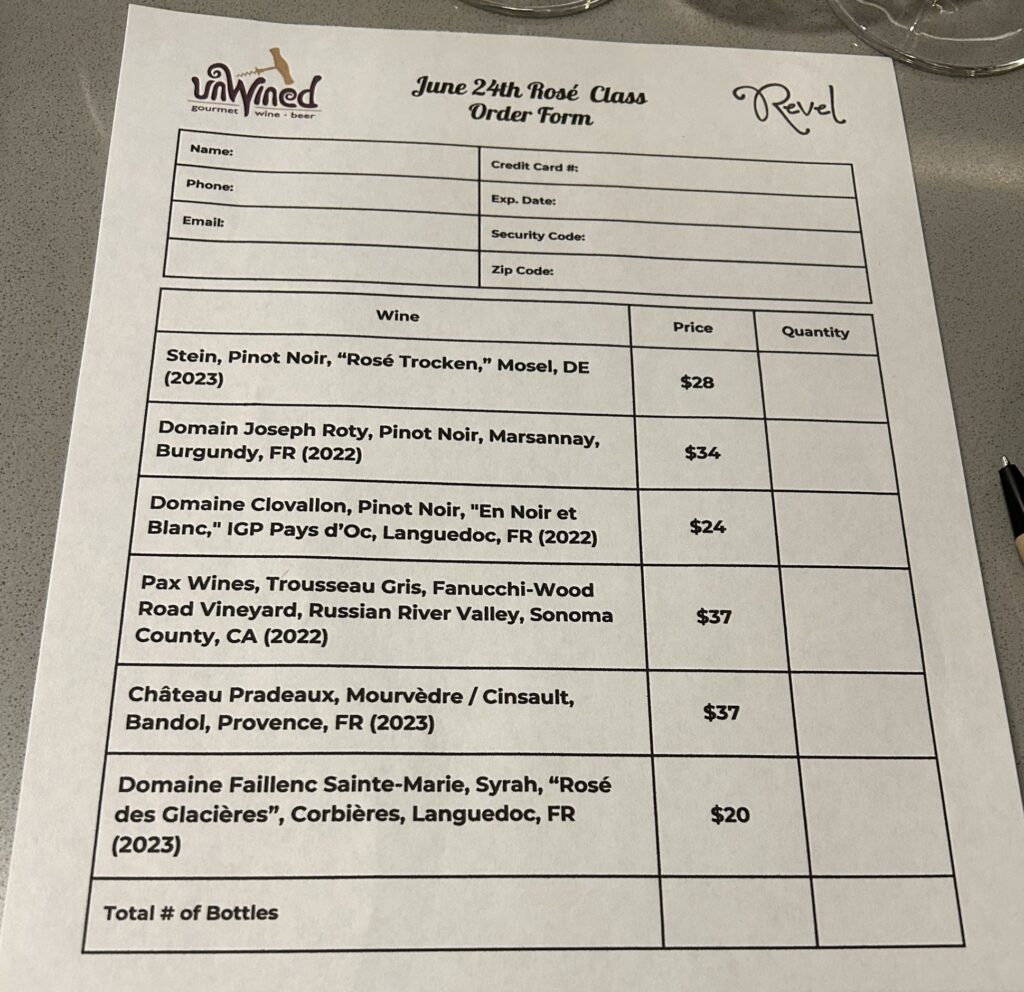
Recently we’ve attended local wine events featuring Champagne and Rose wines.
The Champagne event was put on by the Neighborhood Restaurant Group, the same folks who hosted the Central Coast tasting in April. Their head wine person Erin told us an interesting story about the Champagne region, how growers have begun to take control back from the famous Champagne houses. In the past growers sold their grapes to houses like Pommery, Mumm and Taittinger, who then produced Champagne. This is roughly the role a negociant plays in other parts of France.
This worked for many years, partially due to the grapes not being very ripe because of poor soil and the colder climate. Houses could combine grapes from many different regions to get a good result. But with improvements in technology came better grapes, and some growers now prefer to make their own bubbly that better represents their specific “terroir.” And because wine details tend to be complicated, it’s happening in the other direction as well. Some houses like Louis Roederer and Dom Perignon are now growing their own grapes. Still, only 5-8 percent of Champagne imported to the U.S. is grower produced.
We covered the traditional method of making Champagne and how dosage (adding sugar) affects the taste. Champagne must spend a minimum of 18 months aging in the bottle (known as on lees). Historically, the Champagne most drank was sweeter than today. Champagne ranges from Brut Nature (zero sugar) to demi sec (way too sweet). Most Champagne is Brut (6-12 grams per liter), and heads up – if you see Extra Dry (12-17 grams/liter) on the label that means it’s sweeter than Brut.

Of the six wines we tasted, our favorite three were the 2018 Vilmart & Cie Grand Cellier D’or, the Gonet-Medeville Brut Premier Cru Tradition, and the Bauget-Jouette Brut Rose.
The Vilmart delivered a lot of red apple, acidity and structure. The Gonet-Medeville tasted like a classic Champagne, with brioche and red and green apple. The Bauget-Jouette added other red fruit like strawberry and raspberry and a slightly sweeter finish. Surprisingly, when we asked about purchasing the best price offered was half off the list price, which was still expensive and far more than retail. So we passed on bringing any home. I suppose that showed that the NRG meant the event to be fun and educational and not a way to sell wine.
The Rose event was hosted by Unwined, a local wine business that also operates the restaurant Revel. Fun fact – the DC Metro area is the #1 consumer of Rose in the country.
As head wine guy Brian told us, the term Rose doesn’t tell you much about the wine. Unlike Champagne, which must be made in that region to be called such, Rose describes a preparation, not a terroir or a grape varietal. To drive home that point we tried six different Roses made from very different grapes and regions.

Brian seemed very excited about the Pax Wine Trousseau Gris, which is made from a rare grape only grown today in the U.S. by Fanucchi-Wood. We thought it was very neutral, tart and then gone off the palate. Our favorites were the Stein Rose Trocken and the Chateau Pradeaux Bandol.
The Stein is a German wine made from the Pinot Noir grape. Mosel is a region known for its Rieslings but this wine was very enjoyable. It had a pretty nose, crisp acidity, and an effervescence on the palate like a tiny hint of bubbles. It was deliciously juicy and dry on the finish.
I wasn’t surprised I liked the Chateau Pradeaux because I’ve enjoyed other Bandol Roses in the past. Most of the harvest there is dedicated to Rose. It’s a bigger and darker wine than the other Roses, with an intense, almost Jolly Rancher watermelon aroma along with apple and strawberry. It’s very full-bodied and more layered than the other wines, still dry on the finish. It’s the wine to serve to someone who says they don’t like Rose.
We brought home two bottles. It’s that time of year for Champagne and Rose wine. Try some at your Fourth of July party!